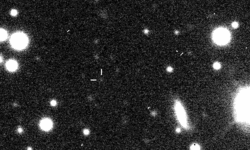Astronomy:Chaldene
 Chaldene imaged by the Canada-France-Hawaii Telescope in December 2001 | |
| Discovery [1] | |
|---|---|
| Discovered by | Scott S. Sheppard David C. Jewitt Yanga R. Fernandez Eugene A. Magnier |
| Discovery site | Mauna Kea Observatory |
| Discovery date | 23 November 2000 |
| Designations | |
Designation | Jupiter XXI |
| Pronunciation | /kælˈdiːniː/ |
| Named after | Χαλδηνή Chaldēnē |
| S/2000 J 10 | |
| Adjectives | Chaldenean /kældɪˈniːən/ |
| Orbital characteristics [2] | |
| Epoch 27 April 2019 (JD 2458600.5) | |
| Observation arc | 17.46 yr (6,376 days) |
| 0.1604721 astronomical unit|AU (24,006,280 km) | |
| Eccentricity | 0.1500864 |
| Orbital period | –759.88 d |
| Mean anomaly | 159.35152° |
| Mean motion | 0° 28m 25.54s / day |
| Inclination | 164.25379° (to ecliptic) |
| Longitude of ascending node | 215.26817° |
| 340.66981° | |
| Satellite of | Jupiter |
| Group | Carme group |
| Physical characteristics[4] | |
| Mean diameter | 4 km |
| Albedo | 0.04 (assumed) |
| Apparent magnitude | 22.5[3] |
| Absolute magnitude (H) | 16.0[2] |
Chaldene /kælˈdiːniː/, also known as Jupiter XXI, is a retrograde irregular satellite of Jupiter. It was discovered by a team of astronomers from the University of Hawaii led by Scott S. Sheppard, in 2000, and given the temporary designation S/2000 J 10.[5][1][6]
Chaldene is about 3.8 kilometres in diameter, and orbits Jupiter at an average distance of 22,713,000 km in 759.88 days, at an inclination of 167° to the ecliptic (169° to Jupiter's equator), in a retrograde direction and with an eccentricity of 0.2916.
It was named in October 2002 after Chaldene, the mother of Solymos by Zeus in Greek mythology.[7]
It belongs to the Carme group, made up of irregular retrograde moons orbiting Jupiter at a distance ranging between 23 and 24 Gm and at an inclination of about 165°.
References
- ↑ 1.0 1.1 MPEC 2001-A29: S/2000 J 7, S/2000 J 8, S/2000 J 9, S/2000 J 10, S/2000 J 11 2001 January 15 (discovery and ephemeris)
- ↑ 2.0 2.1 "M.P.C. 115890". Minor Planet Circular. Minor Planet Center. 27 August 2019. https://minorplanetcenter.net/iau/ECS/MPCArchive/2019/MPC_20190827.pdf.
- ↑ Sheppard, Scott. "Scott S. Sheppard – Jupiter Moons". Department of Terrestrial Magnetism. Carnegie Institution for Science. https://sites.google.com/carnegiescience.edu/sheppard/moons/jupitermoons. Retrieved 26 November 2020.
- ↑ "Planetary Satellite Physical Parameters". Jet Propulsion Laboratory. 19 February 2015. https://ssd.jpl.nasa.gov/?sat_phys_par#jupiter. Retrieved 26 November 2020.
- ↑ IAUC 7555: Satellites of Jupiter 2001 January 5 (discovery)
- ↑ MPEC 2001-T59: S/2000 J 8, S/2000 J 9, S/2000 J 10 2001 October 15 (revised ephemeris)
- ↑ IAUC 7998: Satellites of Jupiter 2002 October 22 (naming the moon)
 |
